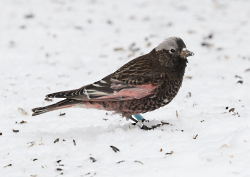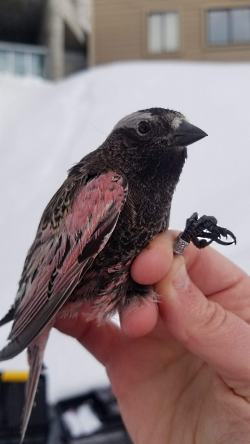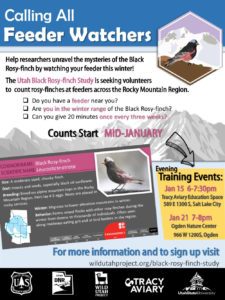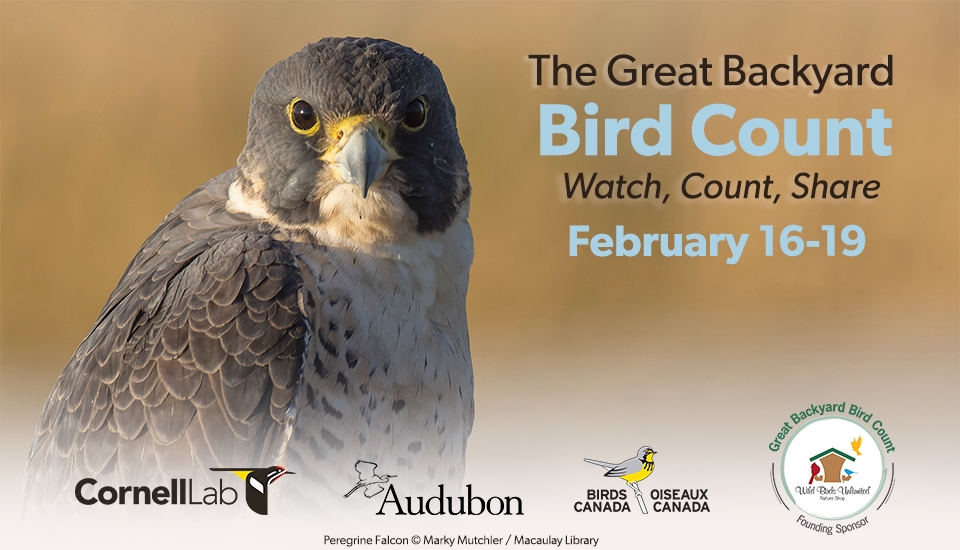
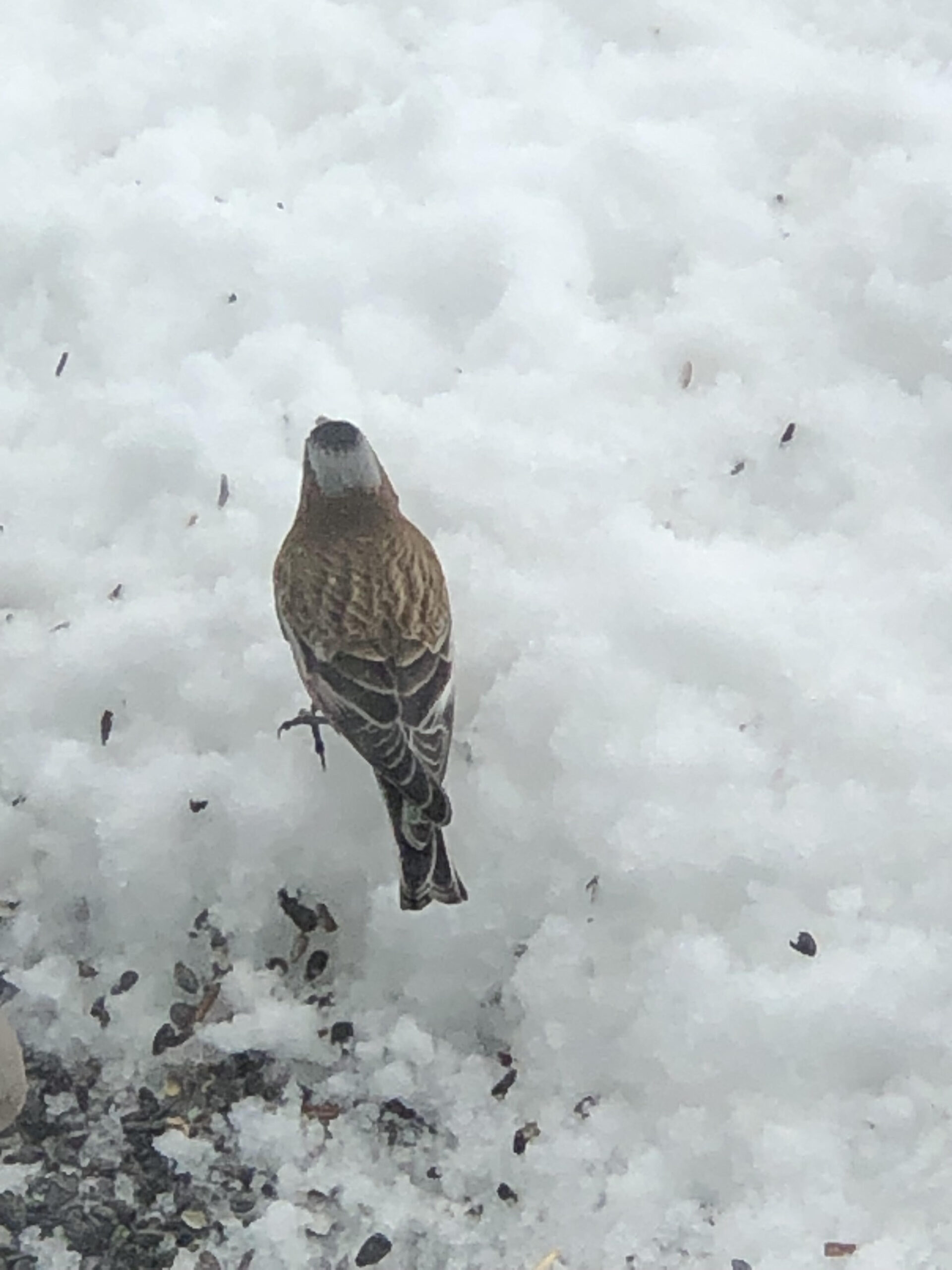 Gray-crowned Rosy Finch
Gray-crowned Rosy Finch
Courtesy & Copyright Hilary Shughart, PhotographerThere are deeply concerning drops in bird populations, and shifting migration ranges and patterns are changing before our eyes, but on the bright side, the crisis presents a strong reason and opportunities for even the most novice birders to be a part of the solution, to contribute to environmental conservation through community science. The Cornell Lab of Ornithology, the National Audubon Society, and Birds Canada urge us to walk into nature and count birds for the mid-February Global Bird Count known as the Great Backyard Bird Count. February is the month to help scientists better understand global bird populations before one of their annual migrations, and the data collected will help bend the curve for bird survival.
“Spend time in your favorite places watching birds–then tell us about them! In as little as 15 minutes notice the birds around you. Identify them, count them, and submit them to help scientists better understand and protect birds around the world. If you already use eBird or Merlin, your submissions over the 4 days count towards GBBC.”
Everything you need to know will be shared in a free online webinar, so “Get ready to flock together for the Great Backyard Bird Count (GBBC)! Panelists will explain how to participate in this exciting global event and how participation might extend past your back door. Discover how to join a group taking part in the GBBC and explore fun ways to involve kids. From bird ID tips to counting birds with ease, this webinar is your ticket to an engaging and confident GBBC experience.”
We’ve posted links for local parks and trails with eBird printable checklists, and it’s encouraging to see the number and variety of species accessible right in town, and in our nearby National Forests and Wilderness Areas. Will you see American Robins, Black-billed Magpies, and Northern Flickers? Can you tell the difference between the American and the Lesser Goldfinch, or the Mountain and Black-capped Chickadee? Will you get lucky and spot a Gray-crowned Rosy finch feasting on black oil sunflower seeds in your own backyard?
There’s no time like the present to establish new traditions for connecting with nature and being part of the solution to the climate challenge. There are ample online resources for new and experienced birders, and in addition to the four local Utah Audubon Chapters, the Birding in Utah Facebook group provides a birding community with expert help with learning how to identify birds even in blurry photos. Team up to be a part of the constellation of community scientists documenting history, and weaving a safety net to ensure that birds have the places they need to thrive today and tomorrow.
I’m Hilary Shughart with the Bridgerland Audubon Society, and I am wild about the National Audubon initiative to promote community science for Bird-Friendly communities, and I am Wild About Utah!
Credits:
Images: Courtesy Great Backyard Bird Count, Cornell Lab of Ornithology et. al.
Gray-crowned Rosy-Finch: Courtesy & Copyright Hilary Shughart
Featured Audio: Courtesy & Copyright © Kevin Colver, https://wildstore.wildsanctuary.com/collections/special-collections/kevin-colver
Text: Hilary Shughart, President, https://bridgerlandaudubon.org/
Additional Reading: Hilary Shughart and Lyle Bingham, https://bridgerlandaudubon.org/
Additional Reading
Other Wild About Utah pieces authored by Hilary Shughart
Global Bird Count in February, Great Backyard Bird Count, https://www.birdcount.org/
About the Great Backyard Bird Count, Every February, count for as little as 15 minutes in your own backyard to help expand our understanding of birds. National Audubon, https://www.audubon.org/conservation/about-great-backyard-bird-count
Global Bird Count in February; Great Backyard Bird Count, Birds Canada, https://www.birdscanada.org/bird-science/great-backyard-bird-count
eBird Field Checklist Sue’s Pond–Logan River Wetlands and Shorebird Playa (178 species), Cache, Utah, https://ebird.org/printableList?regionCode=L586105&yr=all&m=
Who Likes What: The Favorite Birdseed of Feeder Regulars and Rarities, Here are the top three seed choices for a variety of species, per a scientific observational study of 1.2 million bird feeder visits. National Audubon, https://www.audubon.org/news/who-likes-what-favorite-birdseed-feeder-regulars-and-rarities
Birding: The Basics & Beyond (1 hr 12 mn video), Natural Habitat Adventures & WWF(World Wildlife Fund), https://www.nathab.com/traveler-resources/webinars/your-daily-dose-of-nature/birding-the-basics-beyond/
Bridgerland Audubon Great Backyard Bird Count Page, https://bridgerlandaudubon.org/birding-tools/birding-events/great-backyard-bird-count/
Howe, Frank, Rosy Finches, Local Bird Spotlight, The Stilt, Bridgerland Audubon Society, December 2009, https://bridgerlandaudubon.org/documents/BAS-Stilts/Stilt-2009/Vol%2038%20Image%2010.pdf
Gray-crowned Rosy-Finch, All About Birds, Cornell Lab of Ornithology, https://www.allaboutbirds.org/guide/Gray-crowned_Rosy-Finch/overview#
“Get ready to flock together for the 2024 Great Backyard Bird Count (GBBC)! Panelists will explain how to participate in this exciting global event and how participation might extend past your back door.”
Beyond the Backyard: All About the Great Backyard Bird Count Webinar, Tuesday, February 13, 1:00-2:00 p.m. Eastern, https://dl.allaboutbirds.org/2024gbbcwebinar

